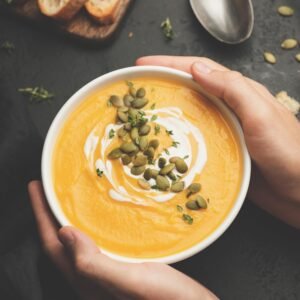Discover the Top Magnesium-Rich Foods to elevate your health. Explore natural ways to boost your magnesium levels with the best food sources.
Did you know pumpkin seeds have 156 mg of magnesium in just 1 ounce? That’s 37% of your daily value (DV). Many Americans don’t get enough magnesium, which is key for health. It helps with muscle and nerve function, blood sugar, and DNA.
Key Takeaways
- Pumpkin seeds provide 156 mg of magnesium per ounce, accounting for 37% of the DV.
- Kidney beans contribute 69 mg of magnesium per cup, making up 16% of the DV.
- One cup of cooked quinoa offers 118 mg of magnesium, equivalent to 28% of the DV.
- Spinach boasts 78 mg of magnesium per 1/2 cup cooked, which is 19% of the DV.
- A medium banana contains 32 mg of magnesium, translating to 8% of the DV.
Eating foods rich in magnesium can boost your levels. This improves your health in many ways. We’ll explore more magnesium-rich foods in the next sections.
Introduction to Magnesium: Importance and Benefits
Magnesium is a key mineral for good health. An adult’s body has about 25 g of magnesium. Half to 60% is in bones, and the rest is in soft tissues. Sadly, about 50% of U.S. adults don’t get enough magnesium, showing its vital role.
Why Magnesium Matters
Magnesium is vital for over 300 body functions. It helps keep the heart beating right, supports bones, and aids nerve signals. Yet, 48% of Americans don’t get enough magnesium from food and drinks, making it crucial to know how to boost intake.
Essential Health Benefits
Magnesium supplements can lower inflammation and heart disease risk. They may also prevent migraines, help with depression and anxiety, and improve sleep. For those with type 2 diabetes, magnesium helps control blood sugar.
Common Deficiency Symptoms
Magnesium deficiency, or hypomagnesemia, shows up as muscle cramps, fatigue, and irregular heartbeat. Normal levels are between 0.75 and 0.95 mmol/L. People with type 2 diabetes often have low magnesium, making it hard to manage blood sugar. So, it’s key to add magnesium-rich foods to your diet.
Seeds and Nuts High in Magnesium
Eating seeds and nuts is a great way to get magnesium. They are full of magnesium and offer other nutrients and health benefits. Let’s explore the best options in these categories.
Key Seeds: Pumpkin, Chia, and Sunflower
Pumpkin seeds are packed with 156 milligrams of magnesium per ounce. That’s 37% of what you need daily. Chia seeds have 111 milligrams per ounce, which is 26% of your daily value. Sunflower seeds have 36 milligrams per ounce, giving you 9% of your daily magnesium.
These seeds are easy to add to your meals. You can put them in smoothies, salads, or baked goods.
Beneficial Nuts: Almonds, Cashews, and Peanuts
Almonds are a standout with 80 milligrams of magnesium per ounce. That’s 19% of your daily magnesium. Cashews have 74 milligrams per ounce, which is 18% of your daily value. Peanuts offer 48 milligrams per ounce, giving you 12% of your daily magnesium.
These nuts are good for magnesium and also for healthy fats, protein, and fiber. They support your overall health.
Here’s a quick summary in a table for easy reference:
| Seed/Nut | Magnesium (mg) per Ounce | % of Daily Value |
|---|---|---|
| Pumpkin Seeds | 156 | 37% |
| Chia Seeds | 111 | 26% |
| Sunflower Seeds | 36 | 9% |
| Almonds | 80 | 19% |
| Cashews | 74 | 18% |
| Peanuts | 48 | 12% |
Adding these magnesium-rich foods to your diet can boost your nutrition. It helps keep you healthy.
Magnesium-Rich Legumes and Beans
Legumes and beans are packed with magnesium. They are not only great for magnesium but also for your health in many ways.
Top Legumes for Magnesium
Kidney beans, lima beans, and baked beans are full of magnesium. Adding them to your meals can help you get enough magnesium. This is important because many people don’t get enough.
Beans: Kidney, Lima, and Baked Beans
- Kidney Beans: One cup of cooked kidney beans has about 69 mg of magnesium. This is about 16% of what you need each day. They are a favorite for those looking for magnesium.
- Lima Beans: Lima beans have even more, with 126 mg of magnesium per cup. This is nearly 30% of your daily magnesium needs. They also have B vitamins, iron, potassium, and fiber.
- Baked Beans: Baked beans have 69 mg of magnesium per cup, or 16% of your daily needs. They are a tasty way to get more magnesium.
These legumes and beans are not just good for magnesium. They also have protein, B vitamins, iron, potassium, and fiber. These nutrients help your heart and keep your blood sugar stable. Eating a variety of these can make your meals both healthy and delicious.
Magnesium in Whole Grains
Whole grains are packed with magnesium and fiber. Adding them to your meals boosts your magnesium intake. They also bring many other nutrients to the table.

Quinoa and Brown Rice
One cup of cooked quinoa has 118 mg of magnesium, which is 28% of what you need daily. It’s great in many dishes, making it a key part of a healthy diet. Brown rice, cooked, also has 86 mg of magnesium per cup, about 20% of your daily needs.
These grains are not just full of nutrients. They also add flavor to your meals. They keep your diet balanced and your body healthy.
Whole Wheat Bread and Shredded Wheat
Whole wheat bread is a top choice for magnesium. A slice gives you 23 mg, which is 5% of your daily value. Two large shredded wheat biscuits have 61 mg, giving you 15% of what you need.
Choosing whole grains like quinoa, brown rice, and whole wheat bread is smart. They give you magnesium and other important nutrients like B vitamins and iron. A diet rich in whole grains is key to staying healthy.
Leafy Greens and Vegetables Packed with Magnesium
Getting enough magnesium is key for good health. Leafy greens and cruciferous veggies are great sources. Adding them to your meals can help you meet your magnesium needs and improve your health.
Spinach, Kale, and Other Leafy Greens
has 24 mg of magnesium, rising to 158 mg when cooked. It gives you about 19.75% of the daily magnesium you need. Kale also has magnesium, though less, but it’s still important in a balanced diet. Eating these greens helps you reach your magnesium goals.
Cruciferous Vegetables: Broccoli and Brussels Sprouts
Broccoli is not just high in fiber but also magnesium. A cup of chopped broccoli has about 21 milligrams of magnesium. It’s also packed with vitamins A, C, E, and K, and minerals like iron and potassium. Brussels sprouts, another cruciferous veggie, add to your magnesium intake and are full of antioxidants.
| Vegetable | Magnesium Content (mg) per 100g | % of RDA |
|---|---|---|
| Raw Spinach | 79 | 19.75% |
| Cooked Spinach | 158 | 37% |
| Raw Kale | 33 | 8% |
| Broccoli | 21 | 5.25% |
| Brussels Sprouts | 23 | 5.75% |
Adding a mix of leafy greens and cruciferous veggies to your diet is smart and healthy. It naturally boosts your magnesium levels. This supports muscle and nerve health, as well as bone strength.
Delicious Fruits Rich in Magnesium
Magnesium from fruits is a great way to get this important mineral. You can enjoy tasty snacks like bananas, avocados, raisins, and prunes. These fruits are full of magnesium, helping you naturally boost your levels.
Bananas and Avocados
Bananas are famous for their potassium, but they also have magnesium. A medium banana has 32 mg of magnesium, which is about 8% of what you need daily. They also have dietary fiber and antioxidants.
Avocados are another great source of magnesium. Half a cup of avocados has about 22 mg of magnesium, or roughly 5% of your daily value. They’re also full of healthy fats, potassium, and B vitamins, making them a superfood.
Raisins and Prunes
Raisins are a tasty way to get more magnesium. Half a cup of raisins has about 23 mg of magnesium, which is about 5% of your daily value. They also have fiber and iron.
Prunes are known for their digestive benefits and also help with magnesium. Half a cup of prunes has slightly less magnesium than raisins but still helps. They’re also full of fiber and antioxidants, making them a healthy snack.
| Fruit | Magnesium Content (mg) | Daily Value (%) |
|---|---|---|
| Bananas | 32 | 8% |
| Avocados | 22 | 5% |
| Raisins | 23 | 5% |
| Prunes | Slightly less than 23 | – |
Top Magnesium-Rich Foods: Boost Your Magnesium Levels Naturally
Boosting your magnesium levels naturally is key for good health. Eating a variety of magnesium-rich foods helps you meet your daily needs. Many Americans don’t get enough magnesium, with only 40% meeting the daily goal and 45% being short.
Adding foods like seeds, nuts, legumes, beans, whole grains, leafy greens, vegetables, and some fruits can help a lot. These foods are packed with magnesium, offering great health benefits.
Seeds and nuts are top magnesium sources. Hemp seeds have 50% of the Daily Value (DV) in just 3 tablespoons. Pumpkin seeds give 37% of the DV in 1 oz. Nuts like Brazil nuts and cashews also provide a good amount of magnesium.
Legumes and beans are also great for magnesium. Lima beans have 30% of the DV per cooked cup. Black beans offer 29%. Whole grains like amaranth and quinoa also contribute a lot, with 38% and 28% of the DV per cooked cup.
Leafy greens and vegetables are not to be missed. Spinach has 37% of the DV, and Swiss chard has 36% per cooked cup. Green peas have 15% of the DV. Adding these to your meals boosts your magnesium levels naturally.
Fruits are also good sources of magnesium. Avocado has 14% of the DV, and bananas have 10% per sliced cup. These foods are easy to add to your diet and are very nutritious.
Here is a table summarizing some of the top magnesium-rich foods and their contributions to the Daily Value:
| Food | Magnesium Content (%DV) |
|---|---|
| Hemp Seeds (3 tbsp) | 50% |
| Pumpkin Seeds (1 oz) | 37% |
| Spinach (cooked cup) | 37% |
| Swiss Chard (cooked cup) | 36% |
| Lima Beans (cooked cup) | 30% |
| Black Beans (cooked cup) | 29% |
| Quinoa (cooked cup) | 28% |
| Avocado (1 avocado) | 14% |
Magnesium from Dairy Products
Magnesium is key for many body functions. Dairy products, including their alternatives, are great sources of this mineral. Adding magnesium-rich dairy to your diet boosts your health. Let’s look at the main sources of magnesium in dairy and how they help meet your daily needs.
Milk, Yogurt, and Cheese
Milk is a common food that also has magnesium. A cup of milk has about 27 mg, which is 6% of the Daily Value (DV). Yogurt, a favorite, has more magnesium, with 8 ounces giving you 42 mg, or 10% of the DV. Cheese, too, is a good source of magnesium, though the amount varies by type.
Dairy Alternatives: Soy Milk
Soy milk is a top choice for those who prefer plant-based options. It has 61 mg of magnesium per cup, which is 15% of the DV. This makes soy milk a great dairy substitute, offering magnesium similar to or better than traditional dairy. It’s also good for those with lactose intolerance or dietary restrictions.
| Product | Magnesium Content (mg) | Daily Value (DV) (%) |
|---|---|---|
| Milk (1 cup) | 27 mg | 6% |
| Yogurt (8 oz) | 42 mg | 10% |
| Cheese (varies) | Varies | Varies |
| Soy Milk (1 cup) | 61 mg | 15% |
Conclusion
Magnesium is key for our health and wellness. It helps our muscles and nerves work right. It also keeps our heart and bones strong. So, getting enough magnesium is very important.
We can get magnesium from foods like seeds, nuts, and legumes. Whole grains, leafy greens, fruits, and dairy products are also good sources. Eating these foods helps us stay healthy.
Eating a balanced diet is the best way to get magnesium. This diet helps our body in many ways. It boosts energy, helps muscles, and sends nerve signals.
Before starting any supplements, talk to a healthcare provider. They can give advice that fits your needs.
Choosing healthy foods for magnesium is good for our wellbeing. Eating a variety of foods helps our body get what it needs. This way, we avoid magnesium deficiency and stay healthy.
The healthiest diet is varied. It gives us all the minerals and vitamins we need. This keeps us vibrant and healthy.
FAQ
Why is magnesium important for human health?
Magnesium is key for our health. It helps over 300 enzyme systems in our body. It’s important for muscle and nerve function, controlling blood sugar, and blood pressure. It also helps make DNA, RNA, and the antioxidant glutathione.
What are some health benefits of magnesium?
Magnesium keeps our heart rhythms steady and supports bone health. It’s also vital for energy production and muscle contraction. It helps maintain overall health and manage blood sugar and pressure.
What are the symptoms of magnesium deficiency?
Signs of magnesium deficiency include muscle cramps and fatigue. An irregular heartbeat is another symptom. It can also cause neurological problems and affect blood pressure and sugar levels.
What seeds are high in magnesium?
Pumpkin, chia, and sunflower seeds are magnesium-rich. Pumpkin seeds have 156 mg per ounce, or 37% of the daily value. Chia seeds offer 111 mg per ounce, or 26% of the daily value. Sunflower seeds have 36 mg per ounce, or 9% of the daily value.
Which nuts are beneficial for boosting magnesium levels?
Almonds, cashews, and peanuts are good for magnesium. Almonds have 80 mg per ounce, or 19% of the daily value. Cashews have 74 mg per ounce, or 18% of the daily value. Peanuts provide 48 mg per ounce, or 12% of the daily value.
Which legumes and beans are rich in magnesium?
Kidney beans, lima beans, and baked beans are magnesium-rich. A cup of cooked kidney beans has 69 mg, or 16% of the daily value. Lima beans provide 126 mg per cup, or 30% of the daily value. Baked beans offer 69 mg per cup, or 16% of the daily value.
What whole grains are high in magnesium?
Quinoa and brown rice are magnesium-rich. A cup of cooked quinoa has 118 mg, or 28% of the daily value. Cooked brown rice provides 86 mg per cup, or 20% of the daily value. Whole wheat products are also good sources.
Which leafy greens and vegetables are packed with magnesium?
Spinach, kale, and collard greens are magnesium-rich. Raw spinach has 24 mg per cup, or 6% of the daily value. Cooked spinach has 158 mg per cup, or 37% of the daily value. Broccoli and Brussels sprouts also have significant magnesium content.
What fruits are rich in magnesium?
Bananas, avocados, raisins, and prunes are magnesium-rich. A medium banana has 32 mg, or 8% of the daily value. Half an avocado has 22 mg, or 5% of the daily value. Raisins offer 23 mg per half-cup, or 5% of the daily value. Prunes also contribute to magnesium intake.
How can I boost my magnesium levels naturally?
To boost magnesium naturally, eat a variety of magnesium-rich foods. Include seeds, nuts, legumes, whole grains, leafy greens, vegetables, fruits, and dairy products. A diverse diet ensures you get enough magnesium.
What dairy products are significant sources of magnesium?
Milk, yogurt, and cheese are magnesium-rich. A cup of milk has 27 mg, or 6% of the daily value. An 8-ounce serving of plain yogurt has 42 mg, or 10% of the daily value. Cheese generally has a good amount of magnesium. Plant-based alternatives like soy milk also offer magnesium.
Source Links
- https://www.verywellhealth.com/foods-high-in-magnesium-7970911
- https://www.healthline.com/nutrition/10-foods-high-in-magnesium
- https://health.clevelandclinic.org/foods-that-are-high-in-magnesium
- https://ods.od.nih.gov/factsheets/Magnesium-HealthProfessional/
- https://www.healthline.com/nutrition/magnesium-benefits
- https://www.webmd.com/diet/foods-high-in-magnesium
- https://www.forbes.com/health/nutrition/magnesium-rich-foods/
- https://www.mindbodygreen.com/articles/nuts-and-seeds-with-the-highest-levels-of-magnesium
- https://www.webmd.com/diet/magnesium-and-your-health
- https://www.medicalnewstoday.com/articles/318595
- https://www.everydayhealth.com/pictures/foods-high-in-magnesium/
- https://www.healthdirect.gov.au/foods-high-in-magnesium
- https://www.medicinenet.com/foods_highest_in_magnesium_raise_my_levels_quickly/article.htm
- https://rootd.com/blogs/vitamins-minerals-101/top-10-magnesium-rich-foods?srsltid=AfmBOoojaJ61NDufrZ8y5H4qRTYWbYiQYzYMuudDsOLzNrGYWw0WeYbb
- https://www.bbcgoodfood.com/howto/guide/what-magnesium
- https://www.prevention.com/food-nutrition/a60749717/foods-high-in-magnesium/
- https://www.health.com/foods-high-in-magnesium-7488037
- https://www.myfooddata.com/articles/foods-high-in-magnesium.php
- https://www.mountsinai.org/health-library/supplement/magnesium
- https://fppn.biomedcentral.com/articles/10.1186/s43014-022-00089-x
- https://bmidoctors.com/slim-down-naturally-best-fruits-to-eat-for-rapid-fat-loss/
- https://www.optimallivingdynamics.com/blog/increase-dopamine-naturally











